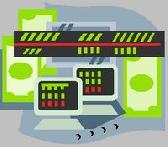Definition of Property, plant, and equipment

Property, plant, and equipment
This item is comprised of all types of fixed assets
recorded on the balance sheet, and is intended to reveal the sum total of all tangible,
long-term assets used to conduct business.
property, plant, and equipment
This label is generally used in financial
reports to describe the long-term assets of a business, which include
land, buildings, machinery, equipment, tools, vehicles, computers, furniture
and fixtures, and other tangible long-lived resources that are not
held for sale but are used in the operations of a business. The less formal
name for these assets is fixed assets, which see.
Related Terms:
Certificates issued by a trust that was formed to purchase an asset and lease it
to a lessee. When the last of the certificates has been repaid, title of ownership of the asset reverts to the
lessee.
Rights of individuals and companies to own and utilize property as they see fit and to receive
the stream of income that their property generates.
The property that portfolio choice can be separated into two independent tasks: 1)
determination of the optimal risky portfolio, which is a purely technical problem, and 2) the personal choice
of the best mix of the risky portfolio and the risk-free asset.
Assets such as land, buildings, machinery, and equipment that the business will use for several
years to make the product or provide the service that it sells. They are shown at the cost a company paid to buy or build them minus the amount they’ve depreciated since they were bought or built. (Except for land, which is not depreciated.)
The cost of equipment owned by the company.
Buildings and machines that firms use to produce output.

The movement of inventory from one company location to
another, usually requiring a transfer transaction.
Amount used during a particular period to acquire or improve long-term assets such as
property, plant or equipment.
Long-lived property owned by a firm that is used by a firm in the production of its income.
Tangible fixed assets include real estate, plant, and equipment. Intangible fixed assets include patents,
trademarks, and customer recognition.
A contra, or offset, account that is coupled
with the property, plant, and equipment asset account in which the original
costs of the long-term operating assets of a business are recorded.
The accumulated depreciation contra account accumulates the amount of
depreciation expense that is recorded period by period. So the balance in
this account is the cumulative amount of depreciation that has been
recorded since the assets were acquired. The balance in the accumulated
depreciation account is deducted from the original cost of the assets
recorded in the property, plant, and equipment asset account. The
remainder, called the book value of the assets, is the amount included on
the asset side of a business.
An informal term that refers to the variety of long-term operating
resources used by a business in its operations—including real
estate, machinery, equipment, tools, vehicles, office furniture, computers,
and so on. In balance sheets, these assets are typically labeled property,
plant, and equipment. The term fixed assets captures the idea that the
assets are relatively fixed in place and are not held for sale in the normal
course of business. The cost of fixed assets, except land, is depreciated,
which means the cost is allocated over the estimated useful lives of the
assets.
management’s plan for investments in longterm
property, plant, and equipment
Expenditures Purchases of productive long-lived assets, in particular, items of property,
plant, and equipment.
The systematic and rational allocation of the cost of property, plant, and equipment
over their useful lives. Refer also to amortization and depletion.
Related to : financial, finance, business, accounting, payroll, inventory, investment, money, inventory control, stock trading, financial advisor, tax advisor, credit.


